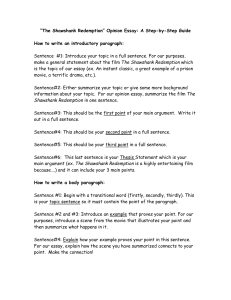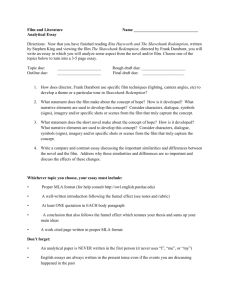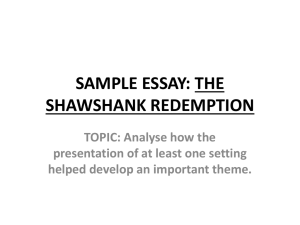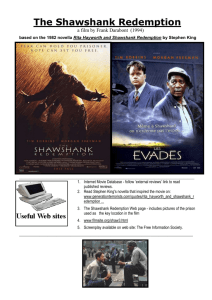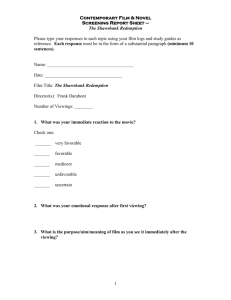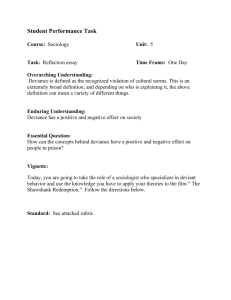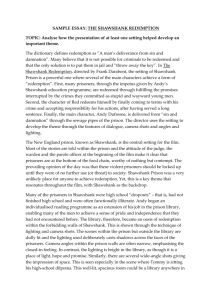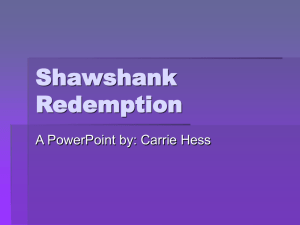Teaching Documentary
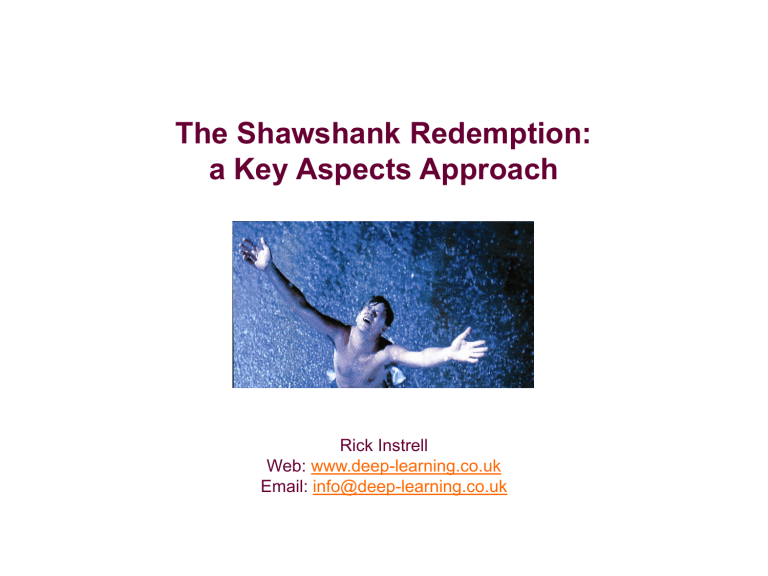
The Shawshank Redemption: a Key Aspects Approach
Rick Instrell
Web: www.deep-learning.co.uk
Email: info@deep-learning.co.uk
INSTITUTION
• internal contexts
• external contexts encode
Key Aspects of Media Studies
CATEGORIES
• medium, purpose, form, genre, style, tone
LANGUAGE
• technical & cultural codes, anchorage, mode of address
NARRATIVE
• narrative structure & narrative codes
REPRESENTATIONS
• selection, portrayal, ideological discourses
TECHNOLOGY
CAPITAL
MEANING select
SOCIETY
• individual, social, cultural, economic, political events & ideologies decode
AUDIENCE
• target audience
• differential decoding influence
TIME
2
The Shawshank Redemption
Categories 1: Medium, Purpose, Form
• Medium:
— novella then film adaptation then television, video and DVD
• Purpose:
— profit from screenings in cinema and on tv, video/DVD sales
— entertainment which allows us the pleasure of ‘escaping’ from everyday reality through fantasies
— emotional release gives a feeling of intensity which may be lacking in our lives
•
Form
— mainstream A feature film with medium budget $25m (budget allowed building of prison set but not major stars or extensive CGI)
3
The Shawshank Redemption
Categories 2: Genre
• Generic hybrid
— prison film
– typical iconography of the genre (characters, locations, props)
– typical narrative of prison film i.e. oppression and escape
— biracial buddy film
– young/old male wisecrack their way through the action; biracial films have black/white crossover appeal.
— caper film
– criminal(s) plan a complex con that will set them up for life
— melodrama
– battle between good and evil with cathartic resolution
4
The Shawshank Redemption
Categories 3: Style & Tone
• Style
— classic narrative style (Establishing shot, shot/reverse shot – although
ES often omitted)
• Tone
— serious, but wry dialogue lightens bleak subject matter.
— nostalgic tone at the start (Inkspots ‘If I Didn’t Care’) establishes that this is oldfashioned ‘good story’.
— story is meant to inspire (Video cover: ‘Fear can hold you prisoner; hope can set you free’)
— uplifting ‘happy’ ending
5
The Shawshank Redemption
Language: Technical Codes
• Technical codes
— story all-important and style unobtrusive
— clear chain of cause and effect – each scene linked to next by dialogue/voiceover and/or causal linkage
— unobtrusive editing – generally continuity editing without ES – style or economic reasons?
— mess hall scenes in first 2/3 of film may have ten or more camera setups and use continuity editing but at the end they use Steadicam with maybe only 2 set-ups – due to fears of running over-budget
6
The Shawshank Redemption
Language 2: Cultural Codes
For example:
— Art Deco font in titles and Inkspots song evoke nostalgic feeling plus establish time and place
— use of posters of Rita Hayworth, Marilyn Monroe and Raquel Welch to signify the passage of time and changing representations of female sexuality
— biblical references
7
The Shawshank Redemption
Language 3: Anchorage
• Voiceover
— not much action in film, so Red’s voiceover is needed to move story along and explain what Andy is feeling
• Music
— Thomas Newman’s score moves from ‘cold’ synthesised music at the start (connotes the harshness of the prison) to more ‘human’ orchestral and piano music when Andy escapes
8
The Shawshank Redemption
Mode of Address
• Indirect address
— used in scenes where events unfold in front of us.
• Direct address
— used when Red gives the voiceover
• General mode of address (rather than specific)
— in that it seems addressed at a wide audience
• Unified mode of address (rather than fragmented)
— it creates a single viewpoint for the audience i.e. the plot is so clear that everyone would construct the same story from it.
9
The Shawshank Redemption
Narrative Structure 1
• Narrative structure (Todorov)
— typical crime film syntax: narrative structure of crime movie: law-breaking, discovery, punishment, resolution cf. Todorov’s equilibrium, disruption, return to equilibrium
— in TSR the equilibrium section is truncated
• Narrative structure (Joseph Campbell)
— Joseph Campbell has suggested that underlying the myths of society there is a monomyth – the hero’s quest: A hero enters an underworld, fights the forces of evil with the aid of helpers and a wise old man. He defeats evil and returns to the everyday world with gifts to bestow to his fellow humans
— Darabont has said that TSR follows this structure.
10
The Shawshank Redemption
Narrative Structure 2
• Film historian Kristin Thompson has analysed Hollywood films from 1910s-
1990s and found that they generally have a 4-part structure with major turning points providing the transitions between the parts:
— set-up: Andy imprisoned and is alone
– turning point 1: Andy advises guards and gets beers for the men
— complicating action: Andy is integrated into the institution & helps
Brooks improves the library; on release Brooks hangs himself because he is ‘institutionalised’
– turning point 2: Andy declares his non-institutionalisation by playing Mozart for the men
— development: Andy helps Tommy and learns that Tommy can prove his innocence
– turning point 3: Tommy is killed on the orders of the warden
— climax: Andy escapes, the warden shoots himself, Red is released,
Red and Andy are reunited
11
The Shawshank Redemption
Narrative Codes
• action code
— typical of prison genre e.g. routine of prison life, meal times, exercise, work, violence, parole hearings, escape.
• enigmatic code
— major enigmas: will Andy be proved ever get out? will Red get parole?
• semic code
— the connotations of the prison (‘one part prison, two parts castle of
Frankenstein’, ‘Gothic quality that draws the eyes skyward’) connotations of religion + horror
• referential code
— the use of film star posters to indicate the passage of some 20 years
(Rita Hayworth, Marilyn Monroe, Raquel Welch)
— biblical references
— music of the period
• symbolic code
— freedom v imprisonment, humanity v brutality, hope v despair
12
The Shawshank Redemption
Explicit Meaning (Preferred Reading) of Narrative
• Darabont has said that he believes you make your own luck by determination and effort – you must believe in yourself no matter how bleak things seem. This is why he liked Stephen King’s original novella.
• Andy: ‘Get busy living or get busy dying’
• Video cover: ‘Fear can hold you prisoner; hope can set you free’
• By believing you can advance you can make it happen and be redeemed
13
The Shawshank Redemption
Gender Representations
• Selection
— a world in which women are absent (the feminine man ‘Fat Ass’ is the first ‘fresh fish’ to freak out – he is ‘feminised’ by having fulsome breasts)
• Portrayal
— The portrayal of masculinity can be expressed in binary oppositions
(male v. female, hard v. soft, unemotional v. emotional)
• Ideologies
— masculinity is an expression of discourse of machismo
14
The Shawshank Redemption
Ethnic Representations
• Selection
— Red is black (Morgan Freeman) – as well as being an Oscar-winning actor he increases crossover appeal.
• Portrayal
— race is not portrayed as an issue in Shawshank. Was it felt that this would be too disturbing an issue to have in a feelgood movie?
— Red is ‘inferior’ to Andy (criminal and uneducated v innocent and educated)
• Ideologies
— lack of racial conflict expresses ideology of US as ‘melting pot’.
— representation of Andy and Red can be seen as expressing discourse of white racial superiority (but also it simply replicates the inequalities of 1940s)
15
The Shawshank Redemption
Representations of Prison
• Selection
— most of film set in prison
— social background of prisoners is not represented
• Portrayal
— prison brutal and dehumanising
— crime seen as fault of individual rather than caused by social conditions
— typical of Hollywood narrative – one outstanding individual escapes
• Ideologies
— expresses individualist ideology of USA – individual solutions to institutional and social problems
16
The Shawshank Redemption
Representations of the American Dream
• Selection
— TSR focuses on individuals, mainly Andy
• Portrayal
— Andy is an outstanding individual whose intelligence and hard work leads to his escape
• Ideologies
— expresses individualist ideology of the USA – anyone with talent and hard work can succeed i.e. make lots of money
17
The Shawshank Redemption
Target Audience
• Target audiences
— seems to be aimed at older filmgoers e.g. 40+ who don’t generally like action blockbusters – use of 1940s-1960s music and movie stars backs this up
— however the film got an MPAA R rating (restricted, adult accompaniment for 17 or under) because violence and rape implied rather than shown
— biracial pairing implies black/white targeting
• Why then is movie popular with all ages and genders?
— perhaps it engages with the ‘structure of feeling’ of many people who feel trapped in oppressive situations (school, work, family life, …) – TSR gives the fantasy of escaping from an oppressive reality to the sun with lots of money
— film seems to have special appeal to Christians in the USA (strange given some of the content)
18
The Shawshank Redemption
Audience Differential Decoding
• Differential decoding: actual audiences decode texts in different ways:
1.
dominant decoding: agree with preferred meaning
2.
negotiated decoding: partial agreement with preferred meaning e.g. accepting the meaning but resisting Christian interpretation
3.
oppositional decoding: disagree with preferred meaning seeing it as expression of dominant ideology e.g. seeing it as an expression of dominant ideologies of USA
4.
non-decoding: seeing it as irrelevant
• AfricanAmerican critics have criticised Freeman’s casting as being typical of Hollywood
• Film-goers whose taste is for art movies with more experimental style and plotting find TSR dull
19
The Shawshank Redemption
Internal Institutional Context 1
• Produced by Castle Rock Entertainment – mini-major who make films to be picked up for distribution by majors
• Had a ‘mythic journey’ story which appealed to studio executives
• Castle Rock Entertainment believe in the right of artistic integrity and gave
Darabont right of final cut but ‘persuaded’ him that his first cut was denying the audience a ‘happy ending’ – the pleasure of seeing Andy and Red reunited (the original had an open unresolved ending where Red was seen on bus to Mexico wondering if he would see his friend again)
• In King novella, the film being watched was The Lost Weekend ; too expensive to use so they used Gilda (cheaper but better as it starred Rita
Hayworth)
20
The Shawshank Redemption
Internal Institutional Context 2
• Darabont’s first feature film so he was teamed with leading cinematographer
Roger Deakins
• Shoot took 57 days and every day over-budget cost $120,000
• Deakins came up with economic and creative solutions to shooting when the film was about to go over-budget e.g. final mess hall scene shot with
Steadicam rather than using separate camera set-ups (cheaper but also more creative as it introduced variety); also just two camera set-ups used in
Warden Norton’s ‘inside out’ programme (again elegant solution came from of financial constraints)
• Test screening led to cutting of some redundant scenes but still 22 minutes over preferred 2 hours
• Film cost $25m and gained $18m on first release. Re-released when gained seven Oscar nominations – took $10m domestically. Phenomenal success on video/DVD and when screened on network tv.
21
The Shawshank Redemption
External Institutional Context
• Gained R rather than NC-17 rating in USA which meant that teenage audience could see it. NC-17 rating would have been given if scenes of violence or rape had been explicit and this would have reduced potential audience (e.g. exclude teens and put off 40+)
22
The Shawshank Redemption
Technology
• Limited budget meant only a small amount of CGI was possible
— harnesses were digitally removed from rooftop scene
— lightning over prison during escape is digital effect
23
The Shawshank Redemption
The Shawshank Redemption: Bibliography
Darabont, Frank (1996) The Shawshank Redemption: Screenplay and Notes .
New York: Newmarket Press.
Kermode, Mark (2003) The Shawshank Redemption . London: BFI.
King, Stephen (1982) Rita Hayworth and the Shawshank Redemption . In King,
Stephen (1996) Different Seasons . London: Warner Books.
24
